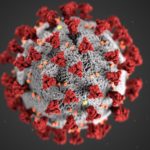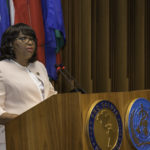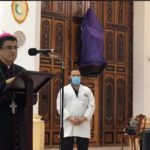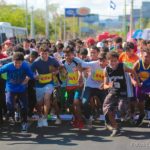Fifty political prisoners were excarcelated this morning, announced the Ortega-Murillo Ministry of Governance via press release. The announcement came hours before a special meeting of the OAS Permanent Council, to discuss the situation in Nicaragua.
The Ortega-Murillo negotiating team issued its own press release, praising the release as evidence of “the Will and Commitment of our Government to the Harmonious Cohabitation in the homes and among the Nicaraguan Families.”
Comunicado del Gobierno de Reconciliación y Unidad Nacional ante la Mesa de Negociación#Canal4Noticias
👉https://t.co/9lHalqKIZk pic.twitter.com/ftnBNxrFHy— Canal 4 Nicaragua (@Canal4Ni) April 5, 2019
Governance’s press release describes the excarcelated prisoners as “people who were detained for crimes against common security and public peace.”
(LaTrincheraNic) Ministerio de Gobernación libera a 50 presos políticos el día de hoy.A continuación les dejamos la nota de prensa y la lista de las personas liberadas.#SOSNicaragua #Nicaragua #Ultimahora #Urgente #Ultimominuto https://t.co/jELSVMv6F0 pic.twitter.com/3iP59JOoWi
— @NicaraguaBot (@NicaraguaBot) April 5, 2019
At the time of their incarcerations, though, the police hyped up the accused as responsible for acts of terrorism and other serious crimes, which are now being euphemistically downplayed as “crimes against common security”.
The legal processes against political prisoners in Nicaragua are rife with irregularities and breaches of due process and procedure, as noted by the Group of Independent Experts of the OAS (GIEI). According to the GIEI, “judicial processes improperly charged students, rural and social leaders with crimes such as terrorism and organized crime, among others, in order to persecute and punish legitimate acts of opposition against the government. The GIEI corroborated the existence of a pattern of judicial criminalization, in which there is no correlation between the facts and the codified criminal conduct (executive summary, p. 5).”
All individuals were either granted house arrest or “other measures”, such as parole, but were not freed or had their judicial files expunged.
In the past, the Interior Ministry published names, IDs and addresses of all excarcerated individuals. This time, only names and government IDs were made available to the public.
These are the people who were excarcelated.
| 1. Aníbal Iván Parrales Jarquín 2. Franklin Rodrigo Artola García 3. Jefferson Edwin Padilla Rivera 4. Jefry José Ortega Orozco 5. Kevin Antonio Mena Bellorín 6. Kevin Roberto Solís 7. Moisés Javier Chévez Cárcamo 8. Wilber Antonio Prado Gutiérrez 9. Jorge Junior Marenco Rojas 10. Gerald Geovanny Espinales Largaespada 11. Allan Enrique Alemán Castillo 12. Brayan Francisco Pérez Ampié 13. Wilmer Antonio Baltodano Salinas 14. Francisco Homero Pérez Bucardo 15. Juan Ramón García Baltodano 16. Marcos Antonio García López 17. Reymundo Gutiérrez López 18. Trinidad Agustín Acevedo Correa 19. Mariela Margarita Sotelo Rodríguez 20. Maribel del Socorro Rodríguez Mairena 21. Raquel Guadalupe Ruiz Borge 22. Fenner Antonio Dávila Gaitán 23. Oscar Danilo Rosales Sánchez 24. Yenki Francisco González Collado 25. Ernesto José Arauz Rizo |
26. Víctor Leonel Velásquez Martínez 27. Etner de Jesús Sequeira Vásquez 28. Franklin Javier Morales García 29. Geovany Ramón Zapata Hurtado 30. Juan Daniel Corea Corea 31. Luis Tomas Fonseca Martínez 32. Miguel Ángel Guerrero López 33. Walter José Mercado Pereira 34. Francisco Ramón Zeledón López 35. Wilmer Rene González Valle 36. Carlos Evert Pineda Herrera 37. Francisco Ramón Valle Sequeira 38. Bryan Alexander Quiroz 39. Fredrych Eliseo Castillo Huete 40. Luis Arnulfo Hernández Quiroz 41. Mathil Alexander Pérez Amador 42. Gerson Snayder Suazo Báez 43. Hamilton Javier Sánchez Quiroz 44. Terencio de Jesús Bautista Rivera 45. Luis Miguel Ramos Lazo 46. Róger Alfredo Martínez 47. Alexander del Socorro Pérez 48. Luis Miguel Díaz Barrios 49. Moisés Alfredo Leiva Chavarría 50. Víctor Manuel Díaz González |
Excarcelations were done secretly, starting at dawn, according to Julio Montenegro, lawyer for the CPDH.
Desde la madrugada de hoy viernes 5 de abril del 2019, se han liberado algunos presos politicos, entre ellos: Oscar Danilo Rosales, Raquel Guadalupe Ruiz y Fenner Antonio Davila, de un listado aproximado de 50 ciudadanos.
— Julio Montenegro (@JulioMonOficial) April 5, 2019
Even though no media was at hand, the homecomings received coverage nonetheless, via social media
This is how Fener Dávila came home. Mr. Dávila was accused of terrorism, kidnapping, bodily harm, and obstruction of public services.
Fener Dávila, originario de La Concepción en Masaya, fue uno de los cincuenta presos políticos excarcelados por la dictadura de Daniel Ortega. pic.twitter.com/ddxxi0hBAm
— Maynor Salazar (@Maynorsalaz) April 5, 2019
Victor Díaz’ relatives shot this video of his homecoming. Mr. Díaz, who is a leader in the Peasant Anti-Canal Movement, was sentenced to 25 years for terrorism, bodily harm, aggravated assault, and obstruction of public services.
(LorenzoVega23) Víctor Díaz, es uno de los 50 presos políticos que han sido excarcelados bajo el régimen de Casa por cárcel.
El #GobiernoDeNicaragua no cumplió con su palabra de darles la libertad completa.#SOSNicaragua pic.twitter.com/SvjXLsI5B8— @NicaraguaBot (@NicaraguaBot) April 5, 2019
Friedrich Castillo poses with a Nicaraguan flag, after his excarceration. Mr. Castillo, a college student who survived the attack on the Divine Mercy church, in July of last year, was sentenced to 16 years in prison for terrorism.
Entre los excarcelados está Friedrich Castillo… pic.twitter.com/mqmjDe3Ptw
— Carlos Mikel Espinoza (@SpotlightNic) April 5, 2019
Jefferson Padilla granted an interview to La Prensa. Mr. Padilla was accused of aggravated robbery, aiding and abetting a fugitive, terrorism, and obstruction of public services. Padilla described being traumatized due to psychological and physical “mistreatment,” that began from the moment of his apprehension.
“The accused me of so many things. They accused me of arson, of organized crime, after beating me. They brought me out [of the cell] nine times. They wouldn’t let me sleep.”
Mr. Padilla described how the police came to his home, destroyed the door, and took him to El Chipote. He said they accused him of burning a microbus, during a protest he did not attend. “They grabbed me because I went to the marches. They were just grabbing anyone,” he said.
Luis Miguel Díaz was greeted enthusiastically in Ometepe. Mr. Díaz was accused of arson, reckless endangerment, aggravated harm, and aggravated robbery against the FSLN.
Hijueputa, estas imágenes si q llegan al corazón y congelan la sangre. Luis Miguel Díaz llega a su casa en la Isla de Ometepe, más animado que nunca para seguir en la lucha, después de ser excarcelado por la dictadura.
“De que se van, se van”, gritó. “El que no brinque es sapo”. pic.twitter.com/ubdvOc8e1P— Miguel Mendoza (@Mmendoza1970) April 5, 2019
🔴 Así fue recibido Luis Miguel Díaz por sus vecinos y sus familiares. Tras la excarcelación y liberación bajo casa por Cárcel.#SOSNICARAGUA #SOSNicaraguaGlobal #CartaDemocratica #SoyMLN #PresosPoliticos pic.twitter.com/Ous7NHopE4
— Movimiento Libertador Nicaragüense (@MovimientoLN) April 5, 2019




